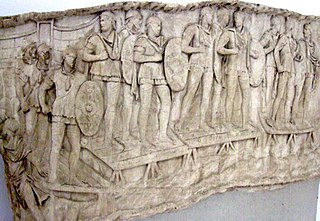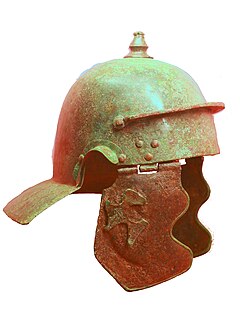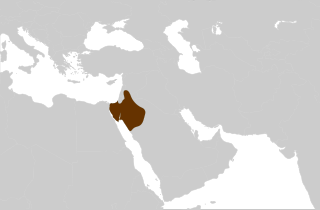
A cohort was a standard tactical military unit of a Roman legion, though the standard changed with time and situation, and was composed of between 360-800 soldiers. A cohort is considered to be the equivalent of a modern military battalion. The cohort replaced the maniple following the reforms attributed to Gaius Marius in 107 BC. Shortly after the military reforms of Marius, each legion formed 10 cohorts. The cohorts were named "first cohort," "second cohort" etc. The first cohort gathered the most experienced legionaries, while the legionaries in the tenth cohort were the least experienced. Until the middle of the third century AD, 10 cohorts made up a Roman legion.

The Auxilia constituted the standing non-citizen corps of the Imperial Roman army during the Principate era (30 BC–284 AD), alongside the citizen legions. By the 2nd century, the Auxilia contained the same number of infantry as the legions and, in addition, provided almost all of the Roman army's cavalry and more specialised troops. The auxilia thus represented three-fifths of Rome's regular land forces at that time. Like their legionary counterparts, auxiliary recruits were mostly volunteers, not conscripts.

Cohors quarta Gallorum equitata was a Roman auxiliary cohort containing both infantry and cavalry contingents. It was probably raised in Gallia Lugdunensis at the time of the founder-emperor Augustus. It is first attested in Moesia in 75 AD and was still in Moesia Inferior in 105. It therefore probably took part in the emperor Trajan's Dacian Wars (99-106). After a brief stay in Thracia, it was transferred to Britannia not later than 122. Its last datable attestation is in 276-82, still at Vindolanda. But the Notitia Dignitatum, a late Roman official document, records a cohors IV Gallorum at Vindolanda under the dux Britanniarum, the commander of limitanei along Hadrian's Wall. The Western section of the Notitia was drawn up in the 420's but the British units must date to before 410, when the island was evacuated by the Roman army.
Cohors tertia Alpinorum equitata was a Roman auxiliary mixed infantry and cavalry regiment. Alpini was a generic name denoting several Celtic-speaking mountain tribes inhabiting the Alps between Italy and Gaul, which were organised as the Tres Alpes provinces.
Cohors prima Raetorum equitata was a Roman auxiliary mixed infantry and cavalry regiment. It is named after the Raeti nation, which dominated the eponymous province Raetia, which comprised much of modern Switzerland and Germany south of the river Danube. The Raeti originally spoke a non Indo-European language closely related to Etruscan. However, by the time their territory was annexed by Rome under founder-emperor Augustus, they had become largely Celtic-speaking through contact with neighbouring peoples such as the Vindelici. Finally, during the centuries of Roman rule, they became Latin speakers: their distinctive provincial patois survives today in the form of the Rhaeto-Romance languages.
Cohors prima Raetorum was a Roman auxiliary infantry regiment. It is named after the Raeti, a designation probably given to some Alpine tribes, which were part of the eponymous province Raetia et Vindelicum, later called simply Raetia. It comprised much of modern Switzerland, western Austria and Germany south of the river Danube. The Raeti originally spoke a non Indo-European language that seems related to Etruscan. However, by the time their territory was annexed by Rome under founder-emperor Augustus, they had become largely Celtic-speaking through contact with neighbouring peoples such as the Vindelici. Finally, during the centuries of Roman rule, they became Latin speakers: their distinctive provincial patois survives today in the form of the Rhaeto-Romance languages.

Cohors tertia Delmatarum equitata civium Romanorum pia fidelis, was a Roman auxiliary cohort mixed infantry and cavalry unit.
Cohors prima Delmatarum milliaria equitata was a Roman auxiliary mixed infantry and cavalry regiment. It was named after, and originally recruited from, the Dalmatae, an Illyrian-speaking people that inhabited the Adriatic coastal mountain range of the eponymous Dalmatia.

The Alpine regiments of the Roman army were those auxiliary units of the army that were originally raised in the Alpine provinces of the Roman Empire: Tres Alpes, Raetia and Noricum. All these regions were inhabited by predominantly Celtic-speaking tribes. They were annexed, or at least occupied, by the emperor Augustus' forces during the period 25–14 BC. The term "Alpine" is used geographically in this context and does not necessarily imply that the regiments in question were specialised in mountain warfare. However, in the Julio-Claudian period, when the regiments were still largely composed of Alpine recruits, it is likely that they were especially adept at mountain operations.

This article concerns the Roman auxiliary regiments of the Principate period originally recruited in the western Alpine regions of the empire. The cohortes Alpinorum came from Tres Alpes, the three small Roman provinces of the western Alps, Alpes Maritimae, Alpes Cottiae and Alpes Graiae. The cohortes Ligurum were originally raised from the Ligures people of Alpes Maritimae and Liguria regio of NW Italia.
The Cohors XX Palmyrenorum was an auxiliary cohort of the Roman Imperial army. It was a cohors equitata milliaria, mixed infantry and cavalry regiment, originally recruited from the inhabitants of Palmyra in Roman Syria. There were also a small number (32-36) of dromedarii forces attached to the infantry.
Cohors PrimÆ Ælia Dacorvm was an infantry regiment of the Auxilia corps of the Imperial Roman army. It was first raised by the Roman emperor Hadrian in the Roman province of Dacia not later than AD 125 and its last surviving record dates c. 400. It was deployed, for virtually its entire history, in forts on Hadrian's Wall on the northern frontier of Britannia province.
Cohors [prima] Batavorum milliaria civium Romanorum pia fidelis was a Roman auxiliary cohort of infantry.
Cohors [prima] Flavia Ulpia Hispanorum milliaria equitata civium Romanorum was a Roman auxiliary regiment containing cavalry contingents. The cohort stationed in Dacia at castra of Orheiu Bistriței and castra Napoca.
Cohors prima Ulpia Dacorum was an infantry regiment of the Auxilia corps of the Imperial Roman army. It was founded by the Roman emperor Trajan, probably in preparation for his planned war against Parthia (113-6). The regiment's honorific title Ulpia refers to the emperor's gens, or clan-name.

Cohors prima Flavia Canathenorum [sagittaria] [milliaria] was a Roman auxiliary cohort of infantry.
The Cohors I Asturum et Callaecorum was a Roman auxilia unit.
The Cohors II Asturum et Callaecorum [equitata] was a Roman auxiliary unit. It is known from military diplomats and brickwork.
Cohors prima Ulpia Galatarum was a Roman auxiliary cohort of infantry.












